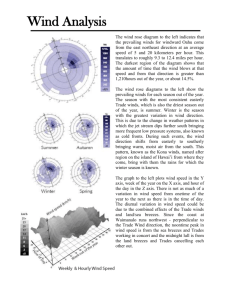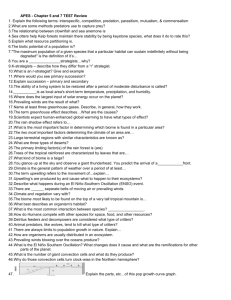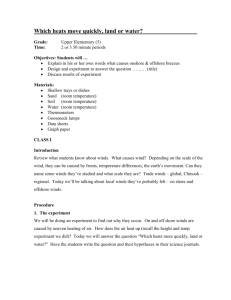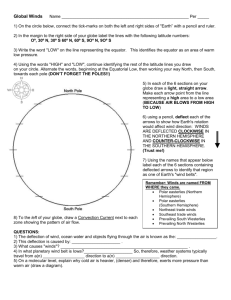Winds & Climate
advertisement
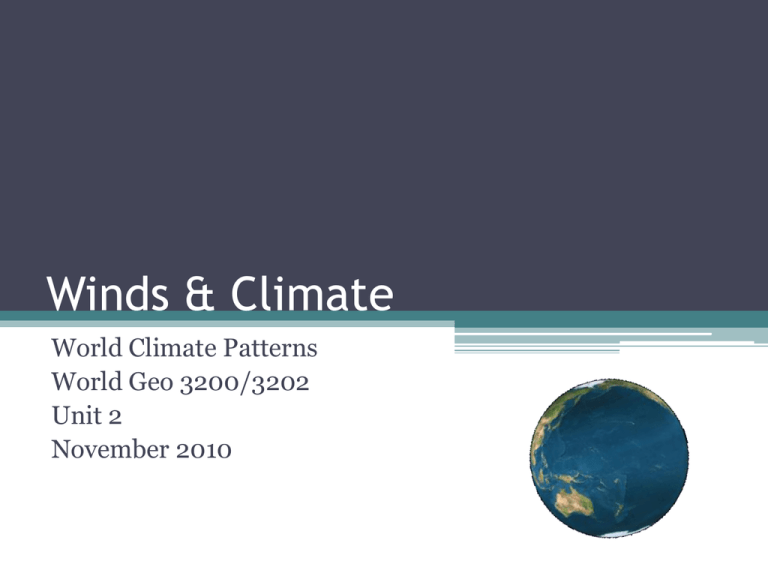
Winds & Climate World Climate Patterns World Geo 3200/3202 Unit 2 November 2010 Lesson Outcomes • 2.3.1 Define the term prevailing winds. (k) • 2.3.2 Describe conditions that result in land breezes and sea breezes. (k) • 2.3.3 State the impact of the Coriolis effect on wind direction. (k) • 2.3.4 Infer how wind systems relate to major pressure belts. (a) High Pressure & Low Pressure • Winds blow from regions of high atmospheric pressure to areas of low atmospheric pressure. • High and low pressures in the earth’s atmosphere are responsible for wind. • Air under high pressure has a tendency to want to “escape” towards low pressure areas High Pressure & Low Pressure • Think—Air inside a balloon. If left untied the air will escape the high pressure of the balloon and create a wind blowing from high pressure inside the balloon to relatively low pressure outside the balloon. • Think—Exhaling: when you exhale the air leaves your lungs because you create a high pressure inside your chest cavity and breath (wind is created from high pressure inside your chest to a lower pressure outside your chest. Prevailing Winds • Regular, predictable, normal wind direction are known as prevailing winds • They are caused by global convection cells in the earth's atmosphere. (fig 4.10 on pg. 63) Prevailing Winds • The global convection cells are created because of the differential heating of the earth's surface. • As the equatorial regions heats the air it rises creating a low pressure at the equator. • The air falls to earth 30º North and south creating high pressure belts. • The other lows and highs can be predicted every 30º of latitude. • Remember that wind directions move from highs to lows • Low pressure belts are created at the equator & at 60° N & S • High pressure belts are created at 30° N & S and at the poles • Remember that wind directions move from highs to lows Local Winds….Sea Breezes (4.8 p 61) • In the day time the land heats much faster than the water (land has greater thermal conductive & water has the ability to dissipate heat at a faster rate) • As a result, the air over the land heats & rises creating a relatively low pressure over the land • The air pressure over the water/sea would be cooler and relatively high • Winds therefore would blow from the sea towards the land as the cool ocean air moves in to replace the warm rising air above the land Local Winds….Sea Breezes (4.8 p 61) • The wind is blowing off the sea hence the name sea breeze • We experience this in a lot of summer time situations. • The opposite is true for ‘land breeze’. Sea Breezes • Remember—winds are named for where they come from; ▫ Easterly winds come out of the east; ▫ Southerly winds come out of the south; ▫ Sea breezes come from the sea. ▫ Land breezes comes from the land. Global Convection Cells • Alternating high and low pressures result from the convection cells. A low pressure belt is created at the equator and at 60º N and 60º S while high pressure belts are created at 30º N and 30ºS and at the poles. • Prevailing Winds form global patterns because of these global pressure belts. They follow the laws of physics and blow from the high pressure belts to the low pressure belts. Prevailing Wind Names • 0-30º N = Northeast trade winds • 0-30º S = Southeast trade winds • 30-60º N and 30-60º S = Prevailing Westerly winds • 60-90º N = North Polar easterlies • 60-90º N = South Polar easterlies Coriolis Effect • The Coriolis effect explains why the winds are deflected in the directions indicated on the in figure 4.11. Coriolis Effect • The coroilis effect is a law of physics that sates: objects in motion in the northern hemisphere are deflected to the right while in the southern hemisphere they are deflected to the left. • Therefore winds in the north are deflected right and the winds in the south are deflected left. Local Weather Patterns • In our area, Eastern North America, prevailing winds are generally from west to east • Generally, air masses move along a path from southwest to northeast • We see this regularly in our weather patterns as low pressure systems (hurricanes, blizzards) move from the Eastern seaboard of the USA up to Atlantic Canada & over NL Local Weather Patterns Review • What causes wind to blow? DIFFERENCES IN AIR PRESSURE • What causes winds to be deflected from a straight path? CORIOLIS FORCE • What causes the development of global convection cells and pressure belts. DIFFERENTIAL HEATING OF THE EARTH • Winds that normally blow in a region are referred to as _?_. PREVAILING Review • When do sea breezes occur? DAY WHEN LAND IS HOTTER THAN SEA • What name is given to the prevailing winds between 60 and 90 degrees N. NORTH POLAR EASTERLIES • What name is given to the prevailing winds between 60 and 90 degrees S. SOUTH POLAR EASTERLIES • What name is given to the prevailing winds between 30 and 60 degrees N. WESTERLY Review • What name is given to the prevailing winds between 60 and 90 degrees S? WESTERLY • What name is given to the prevailing winds between 0 and 30 degrees N? Northeast trade winds • What name is given to the prevailing winds between 0 and 30 degrees S. SOUTHEAST TRADE WINDS • When hot air rises what type of pressure is created?





